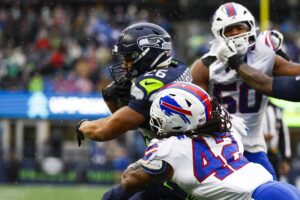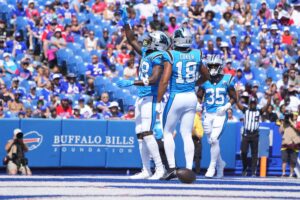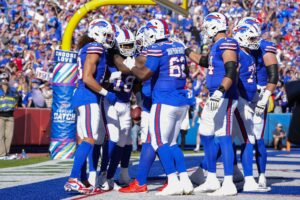The New Orleans Saints executed an unfamiliar game plan in their gritty 24-23 win over the Baltimore Ravens. Offensively, it was their second-lowest yard and point total of the season. It wasn’t a spectacular defensive performance either, with 351 yards surrendered. But according to head coach Sean Payton, the game unfolded as he expected.
“We didn’t think it would be a high-scoring game and points would be a premium and field position would be more of a premium,” Payton said after the game. “We wanted to play as much as we could on their half of the 50 [yard line].”
Ball control was Baltimore’s strength coming into the game, but the Saints offense topped them in nearly every category related to ball control. Defensively, New Orleans capitalized on the Ravens weaknesses despite the significant yardage allowed. A deeper look at the box score shows how New Orleans achieved victory despite being out-gained by Baltimore.
How the New Orleans Saints Beat Baltimore Ravens at Their Own Game
Long Opening Drive
New Orleans started with a 20-play drive that ate up over 10 minutes of the first quarter and ended with zero points. Surely this was frustrating for New Orleans after successfully converting on three fourth-down attempts before losing a fumble on another fourth-down attempt in the red zone. One could dismiss this opening drive as a waste of time, but in the context of the Saints gameplan, it was an effective waste of time.
When the Saints held the ball for 10:03, they burned one-sixth of the total game time before the Ravens had a chance to establish their offense. Turnovers are never acceptable, but the fumble set Baltimore up at their own six-yard line which is a less than ideal starting point for an initial possession. The Ravens first possession stalled after just seven plays.
Neither team scored until a Ravens field goal with six minutes remaining in the half. The Saints would have been better off by settling for a field goal on their opening possession, but ultimately it allowed New Orleans to get a long initial look at the Ravens defense and prevented Baltimore from establishing their offense early.
Time of Possession
Beyond the first drive, New Orleans did a better job with ball control overall. Baltimore entered the game ranked third or better in each of the following categories: average time of possession, plays run, and first downs. The Saints topped them in each category, with 33:31 time of possession, six more plays run, and one more first down. The Saints 26 first downs were the most allowed by the Ravens this season.
New Orleans also matched Baltimore’s red zone success rate (three scores on four attempts) and slightly exceeded the Ravens conversion rate on third downs. The Saints converted on six of 14 attempts, compared to Baltimore’s five conversions on 12 attempts. Baltimore boasted the league’s third-best red zone success rate and the fourth-best third down percentage heading into the game.
A steady Saints run game was perhaps the biggest reason for their success in these areas. New Orleans only averaged 3.4 yards per carry but still gained 134 yards on 39 attempts. This was the highest total of rushing attempts and yards allowed by Baltimore so far this season. Additionally, New Orleans was able to pick up 12 first downs on the ground, matching their 12 first downs earned through the air.
Forcing the Ravens to Face Their Weaknesses
Another way the Saints controlled the clock was by pushing the Ravens to run nearly twice as many pass plays (41) as run plays (23). Meanwhile, New Orleans ran 39 times compared to 31 pass plays. Baltimore exceeded 41 pass plays in two games earlier this season, both of which were losses. A loss to the Cincinnati Bengals was the only game where Baltimore finished with fewer rushing yards and attempts than their 77 yards on 23 carries against New Orleans.
Baltimore averaged 5.5 yards per play, topping the Saints 4.8-yard average, but it didn’t matter since New Orleans ran six more plays and had a better conversion rate on third down. It also helped that Saints quarterback Drew Brees completed 73.3 percent of his passes despite averaging less than 10 yards per completion. Ravens quarterback Joe Flacco averaged 12.1 yards per completion but he completed 58.9 percent of his pass attempts, falling just below his 61.7 percent completion percentage on the season.
One of Baltimore’s biggest weaknesses in the first six weeks was their lack of early down production. This had forced them into 96 third-down attempts; the NFL’s second-highest total heading into week seven. The Saints defense held strong on early downs, forcing the Ravens into third and six or longer on seven of their 12 third down attempts. Baltimore successfully converted on only one of these third and long plays.
Mirroring Aspects of the Ravens Gameplan
New Orleans proved more effective than Baltimore at deploying their athletic backup quarterback on gadget plays. Amazingly, this is an actual NFL metric in 2018. Taysom Hill gained 35 yards on six carries, while Lamar Jackson was held to nine yards on three carries, although one carry went for a touchdown. Jackson also completed one pass for five yards.
Since both players had already seen a lot of action this season, it wasn’t surprising to see them involved on Sunday. However, it was downright shocking to see the Saints tight ends finish with better numbers than Baltimore’s tight end group.
Baltimore’s four tight ends had combined for 40 receptions and 410 receiving yards in the first six weeks. On Sunday, they were targeted five times, resulting in just two catches for 16 yards and a touchdown. Meanwhile, Saints tight ends Ben Watson and Dan Arnold combined for eight catches, 78 yards and a touchdown on nine targets.
This was no coincidence. New Orleans went with more three tight end sets than usual and ran multiple pass plays from these looks. Arnold had been active in only one other game this season.
Multiple tight end sets have been crucial to Baltimore’s success this season since these are effective run formations and their four tight ends are all capable receivers. On Sunday, New Orleans not only borrowed this approach, but they also executed it better than Baltimore.
Closing Thoughts
In the end, a missed potential game-tying extra point by Justin Tucker made the difference. With both offenses catching fire in the fourth quarter, we’ll never know what would have happened in overtime. Nonetheless, the Saints did just enough to win and it just might be one of their most impressive wins since Payton and Brees arrived in New Orleans.
This win came on the road in cold, windy conditions against the league’s top-ranked defense in both points and yards allowed, and a team Payton and Brees had yet to beat. It’s an encouraging performance for a Saints team that faces three winning teams and the Super Bowl Champion Philadelphia Eagles in the next four weeks.






